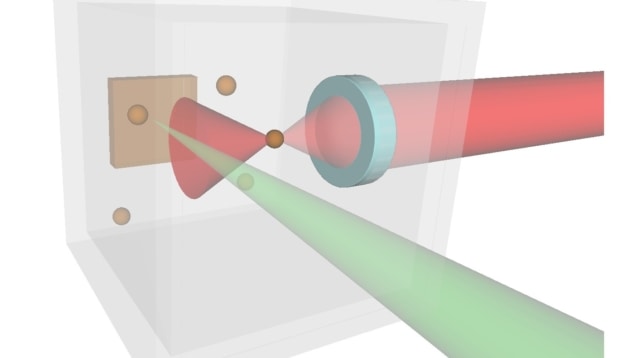 Superfluid focus: Schematic showing how a laser (green) is fired at a gold surface in a superfluid to create nanoparticles. The nanoparticles are then held in optical tweezers, which are created by focussing another laser (red) in the superfluid. (Courtesy: Yosuke Minowa/Osaka University)
Superfluid focus: Schematic showing how a laser (green) is fired at a gold surface in a superfluid to create nanoparticles. The nanoparticles are then held in optical tweezers, which are created by focussing another laser (red) in the superfluid. (Courtesy: Yosuke Minowa/Osaka University)
Optical tweezers have been used to manipulate nanoparticles within superfluid helium at a chilly 1.4 K. The experiment is described as the “first successful application of optical tweezers at ultralow temperatures,” by Yosuke Minowa – who achieved the feat along with colleagues at Osaka University in Japan. The researchers believe that their work could lead to a better understanding of the interface between the classical and quantum worlds.
When liquid helium is cooled to about 2 K, it transforms into a quantum state of matter that has zero viscosity and can therefore flow forever without any loss of kinetic energy. This superfluid helium has several curious properties, such as the ability to climb up the walls of a container and escape captivity. Furthermore, excitations such as vortices in the superfluid are quantized.
While superfluid helium has been studied extensively since its discovery 85 years ago, some of the physics behind superfluidity remains a mystery. Improving our knowledge of the phenomenon goes well beyond the bounds of the Earth because superfluidity is believed by some to exist inside neutron stars.
Focussed beam
One poorly understood area is how superfluids interact with objects such as nanoparticles, whose behaviour straddles the border between quantum and classical physics. In this experiment at Osaka, researchers introduced gold or zinc oxide nanoparticles (about 10–80 nm in size) to superfluid helium. This was done by firing a laser at a gold or zinc oxide surface that is immersed in the superfluid, knocking nanoparticles off the surface and into the superfluid.
Another laser beam was strongly focussed to a small region within the superfluid to create optical tweezers, which could hold the nanoparticles in place for up to 30 minutes.
Read more

Sound waves in fermionic superfluid are studied in a ‘beautiful’ experiment
Optical tweezers are an established technique that make use of the fact that the electric field gradient in a laser beam is greatest at the focal point and this attracts and holds nanoparticles. However, the team say that this is the first time that optical tweezers have been used at such low temperatures.
As well as offering a way to study interactions between classical and quantum physics, Minowa and colleagues believe that nanoparticles held in optical tweezers could provide a way of studying quantized vortices in superfluids. For example, the nanoparticles could be used to visualize or even control these quantum states.
The research is described in Optica.

